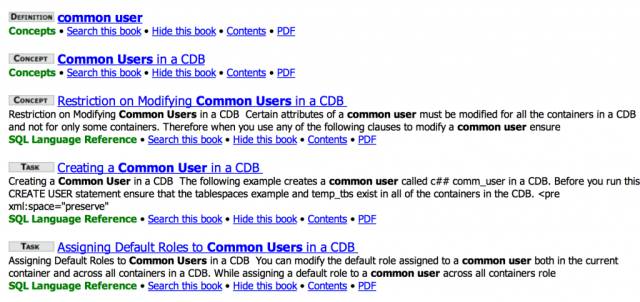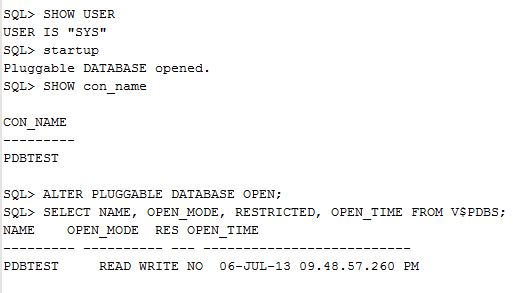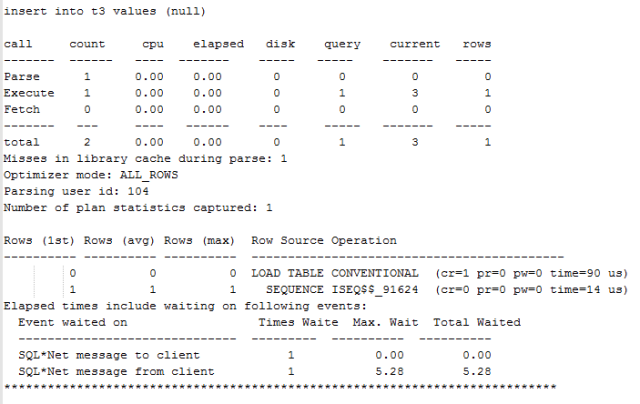以12c Identity类型示范自我探索式学习方法
题记:这篇文章首先我会从几个方面介绍下我的学习思路和方法,供大家参考。然后借助案例分析的过程来分享在技术研究中的一些技巧。作为一个做技术的人,方法很重要。凡事只有掌握了有效的方法,才能在学习的过程中事半功倍。但我并不主张笼统地谈正确的学习方法是什么,因为不同的技术领域,甚至是不同的知识背景,都有其特殊性,那就要求我们在学习的过程中发现知识的特殊性,并找到最适合的学习方法。
首先描述一下我自己在学习新知识的时候大概是什么状态,什么思路,因为自认为自己的学习能力还不错,因此也期望这样的学习方法对其他人会有帮助。看这篇文章的时候,你可以同步地想一想如果是你遇到这样的错误,你会怎么处理,怎么发散,怎么研究?
Oracle Database12c作为最新一代的Oracle数据库产品,已经广为使用,那么,如果学习一个新版本的数据库,应该如何开始呢?
我通常是从New Features Guide文档看起,先通览文档的目录,遇到感兴趣的新功能点,就开始做实验来验证这个新功能。当然,这之前需要先把新版本的数据库安装好、新版本的全部文档下载到本地,这样即使你坐在飞机上也有文档可查。
这次我的计划是实验一下Identity类型的字段,这个字段可以用来作主键,会自动递增,这种类型的字段在SQL Server中早就存在,但是Oracle直到12c才推出这个功能。
通常我不会用sys用户进行任何实验(除非是验证sysdba的新功能),因此总是会先创建一个我自己的dba用户。
在12c中创建这个用户首先就遇到了错误(测试环境启用了多租户架构)。
SQL> CREATE USER kamus IDENTIFIED BY oracle DEFAULT tablespace users;
ERROR at line 1:
ORA-65096: invalid common USER OR ROLE name
对于一个不熟悉的错误,第一件事情不是去Google,而是用oerr实用程序来看看Oracle自己对这个错误是怎么解释的。为什么我喜欢非Windows环境中的Oracle?oerr的存在也是很大一个原因。

错误信息的解析非常明确地告知“试图创建一个通用用户,必须要用C## 或者c##开头”,这时候心里会有疑问,什么是common user?但是我通常不会先急着去翻文档,而是先把手头的事情做完,也就是先把用户创建上。
SQL> CREATE USER c##kamus IDENTIFIED BY oracle DEFAULT tablespace users;
USER created.
SQL> GRANT dba TO c##kamus;
GRANT succeeded.
创建C##KAMUS用户成功之后,再返回去解决心中的疑问,什么是common user?在联机文档的左上角搜索关键字common user,会得到如下图所示的结果。

通常我会先浏览目录,如果看完觉得心中疑问已经解决,就会返回继续做之前的实验,不会再浏览其他的链接;如果想要查询怎么做,比如说如何创建common user,才会继续去看正文部分。这样的好处是可以保持专注不至于被过多文档分心。
但是由于common user这个概念几乎是崭新的,所以我很有兴趣继续探索一下:跟common user相对的local user该如何创建。继续去看正文当然是个方法,但是这里我选择的是直接去看SQL Language Reference,因为我们知道一定是在Create User语法里面会有不同的定义,进入Create User语法页面,直接搜索common user,就可以看到如下这段话。
CONTAINER Clause:
To create alocal user in a pluggable database (PDB), ensure that the current container is that PDB and specify CONTAINER= CURRENT. To create a common user, ensure thatthe current container is the root and specify CONTAINER = ALL. The name of thecommon user must begin with C## or c##. If you omit this clause and the currentcontainer is a PDB, then CONTAINER = CURRENT is thedefault. If you omit this clause and the current container is the root, then CONTAINER = ALL is the default.
也就是说我们一定要先登录进一个PDB,才可以创建本地用户,那么如何知道现在的SQL*Plus是登录进了哪个DB呢?这个疑问其实是一个很简单的联想,既然需要去一个地方,那么一定有方法知道我现在在什么地方,通过简单地查询文档,可以得知以下的方法。现在确实在CDB中。

dbca建库的时候,有一个新选项是“同时创建PDB”,我勾选过(对于dbca中出现的新选项,如果不是条件不允许,我都会选中进行测试),创建了名字为pdbtest的PDB,那么现在我想尝试登录这个PDB,去创建一个local user。
如何登录PDB?
Administrator’s Guide中有专门的一个章节“PartVI Managing a Multitenant Environment”来描述如何管理多租户环境,浏览目录就可以直接找到“Connecting to a PDB with SQL*Plus”这部分,如下所示。
You can use thefollowing techniques to connect to a PDB with the SQL*Plus CONNECT command:
Databaseconnection using easy connect
Databaseconnection using a net service name
那尝试直接使用easy connect来登录PDB。

进行如下操作。

PDB没有Open?
尝试打开。无法使用startup命令。原因是我使用了旧版本的SQL*Plus(如上所示是10.2.0.4.0)连接到12c数据库的PDB中,某些新特性不被支持。
SQL> startup
ORA-24543: instance startup OR shutdown NOTallowed IN pluggable DATABASE
使用12c自带的SQL*Plus登录,就可以使用startup命令将PDB打开,使用SQL*Plus管理PDB的详细命令可以参看文档描述。
或者可以使用如下语句打开PDB。

到此,可以创建localuser了。
SQL> CREATE USER kamus IDENTIFIED BY oracle;
USER created.
SQL> GRANT dba TO kamus;
GRANT succeeded.
那么在一个PDB中可以看到多少用户呢?可以看到CDB中的用户吗?
这又是一个简单的联想,学习的过程其实是一个发散再收缩的循环。看来不可以,只能看到自己的用户,当然这里有很多common user。可以看到即使是在PDB中,cdb_视图也是可以使用的。
SQL> SELECT CON_ID,COUNT(*)
FROM cdb_users GROUP BY con_id;
CON_ID COUNT(*)
---------- ----------
3 38
再回到CDB中看一下,会是什么情况?可以看到所有容器数据库中的用户都可以查询到。
SQL> SELECT CON_ID,COUNT(*)
FROM cdb_users GROUP BY con_id;
CON_ID COUNT(*)
---------- ----------
1 36
2 35
3 38
终于,我可以回到最开始的实验目标上去了,在PDB中创建了T1表,id列为Identity类型。
SQL> CREATE TABLE t1 (id NUMBER GENERATED AS IDENTITY);
TABLE created.
根据文档描述,Identity类型仍然是通过Sequence来实现的,那么应该是自动创建了一个Sequence,果然如此。在你学习的过程中会多此一步来查询一下Sequence视图吗?
SQL> SELECT SEQUENCE_NAME FROM user_sequences;
SEQUENCE_NAME
--------------
ISEQ$$_91620
默认创建的Sequence,CACHE_SIZE是20,开始值是1,这都跟单独创建的Sequence默认值一样。

插入一条数据试一下,报错报错还是报错。所以是generated always的identity列,如果只有这一列,就没法插入数据。

换GENERATED BYDEFAULT ON NULL 类型试一下,Wait,如果删除了表,对应的序列会自动删除吗?理论上应该会,当然还是要测试一下。
SQL> DROP TABLE t1;
TABLE dropped.
序列还在?

再建一张测试表。
SQL> CREATE TABLE t2 (id NUMBER GENERATED BY DEFAULT ASIDENTITY);
TABLE created.
现在是2个序列了。

写完整的Drop语句试一下。
SQL> DROP TABLE t2 cascade CONSTRAINT purge;
TABLE dropped.
后面创建的序列已经被自动删除了,之前创建的还在。

两者的不同应该是purge,如果被删除的表还在回收站中,序列是会保留的,因为表还可能从回收站里面再restore回来,需要保证序列仍然有效。那么清空回收站实验一下。
SQL> purge recyclebin;
Recyclebin purged.
果然,相应的序列也被删除了。
SQL> SELECT * FROM user_sequences;
no ROWS selected
再回到正题,创建T3表,插入一条数据。

序列的LAST_NUMBER已经增加为21。

后台如何操作的?使用10046trace,再插入几条数据。
SQL> INSERT INTO t3 VALUES(NULL);
1 ROW created.
SQL> INSERT INTO t3 VALUES(NULL);
1 ROW created.
SQL> SELECT * FROM t3;
ID
----------
1
2
3
查看10046 trace的结果。可以看到执行计划中直接调用了SEQUENCE,就跟之前插入记录的时候明确指定SEQ.NEXTVAL一样。其实Oracle的实现方法非常简单,这一列其实就是Number类型,然后将这一列的Default值设置为”KAMUS”.”ISEQ$$_91624″.nextval,仅此而已。

使用DBMS_METADATA.GET_DDL获取到的DDL信息,已经符合12c语法的样式了,显示出了Sequence的具体信息。

系统自动产生的序列无法手工修改属性。

系统自动产生的序列也不允许删除。

在11gR2中,错误信息编号在ORA-32790和ORA-32800之间是空白,而12c使用了这其间的8个错误号作为新特性的报错。
ORA-32791: prebuilt table managed column cannot have a default on null.
Cause: An attempt was made to create a materialized view on a prebuilt table that has a managed column with a default on null expression.
Action: Either remove the default on null property, or do not include the column in the materialized view definition.
ORA-32792: prebuilt table managed column cannot be an identity column
Cause: An attempt was made to create a materialized view on a prebuilt table that has a managed column that is an identity column.
Action: Either remove the identity property, or do not include the column in the materialized view definition.
ORA-32793: cannot alter a system-generated sequence
Cause: An attempt was made to alter a system-generated sequence.
Action: A system-generated sequence, such as one created for an identity column, cannot be altered.
ORA-32794: cannot drop a system-generated sequence
Cause: An attempt was made to drop a system-generated sequence.
Action: A system-generated sequence, such as one created for an identity column, cannot be dropped.
ORA-32795: cannot insert into a generated always identity column
Cause: An attempt was made to insert a value into an identity column created with GENERATED ALWAYS keywords.
Action: A generated always identity column cannot be directly inserted. Instead, the associated sequence generator must provide the value.
ORA-32796: cannot update a generated always identity column.
Cause: An attempt was made to update an identity column created with GENERATED ALWAYS keywords.
Action: A generated always identity column cannot be directly updated.
ORA-32797: identity column sequence mismatch in ALTER TABLE EXCHANGE PARTITION.
Cause: The two tables specified in the EXCHANGE have identity columns with sequences that are neither both increasing nor decreasing.
Action: Ensure that the identity columns have sequences with INCREMENT BY having the same sign.
ORA-32798: cannot use ANSI RIGHT or FULL outer join with a left correlation.
Cause: An attempt was made to use a lateral view with a left correlation to the first operand of an ANSI RIGHT or FULL outer join.
Action: Rewrite the query without the left correlation.
到此为止可以休息一下了,从ORA-65096开始大概花费了1个多小时的时间,我学习到了:
1、什么是common user,什么是local user?
2、如何查询现在的环境是CDB还是某个PDB?
3、如何登录PDB?
4、如何启动PDB?
5、PDB和CDB中视图看到的内容有怎样的不同?
6、如何创建Identity类型的列?
7、删除表以后,对应的Sequence如何处理?
8、Oracle后台对于Identity列是如何处理的?
你是不是也是这样学习的呢?
节选自《Oracle性能优化与诊断案例精选第五章》